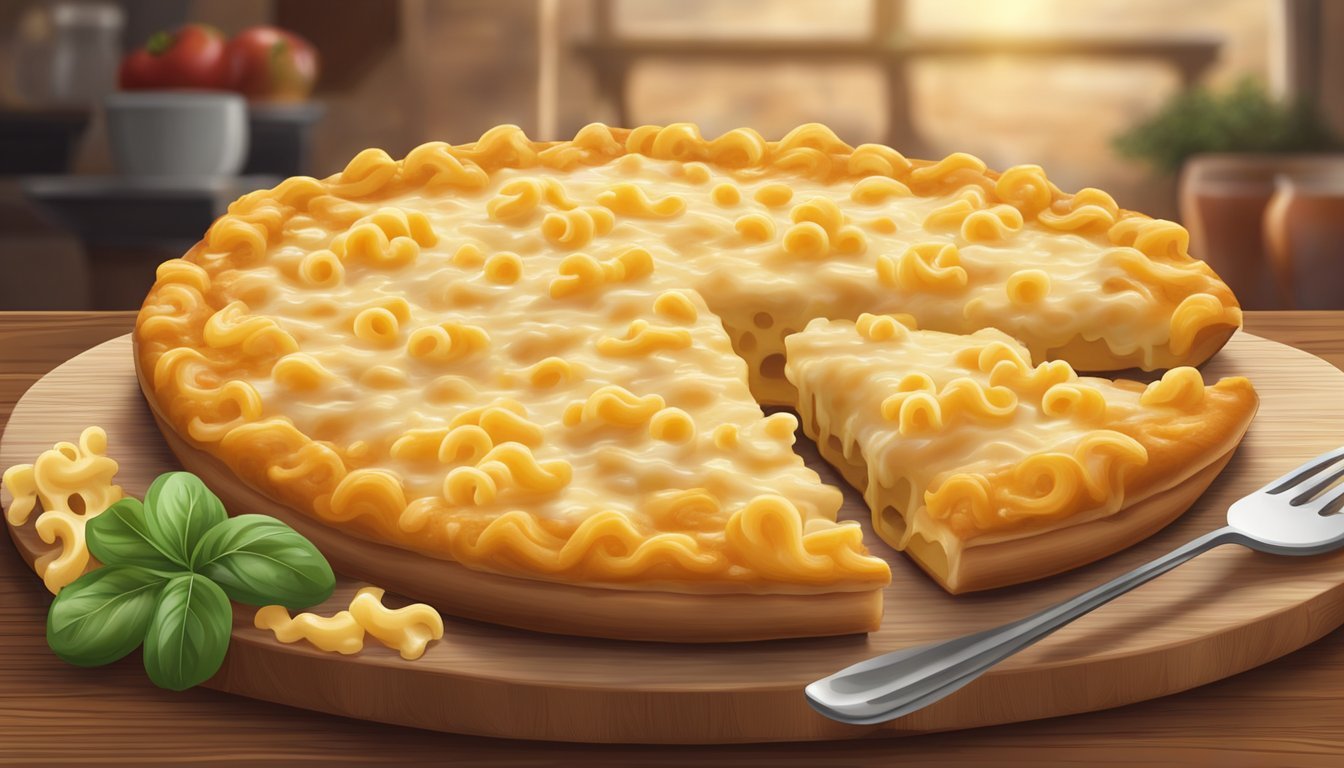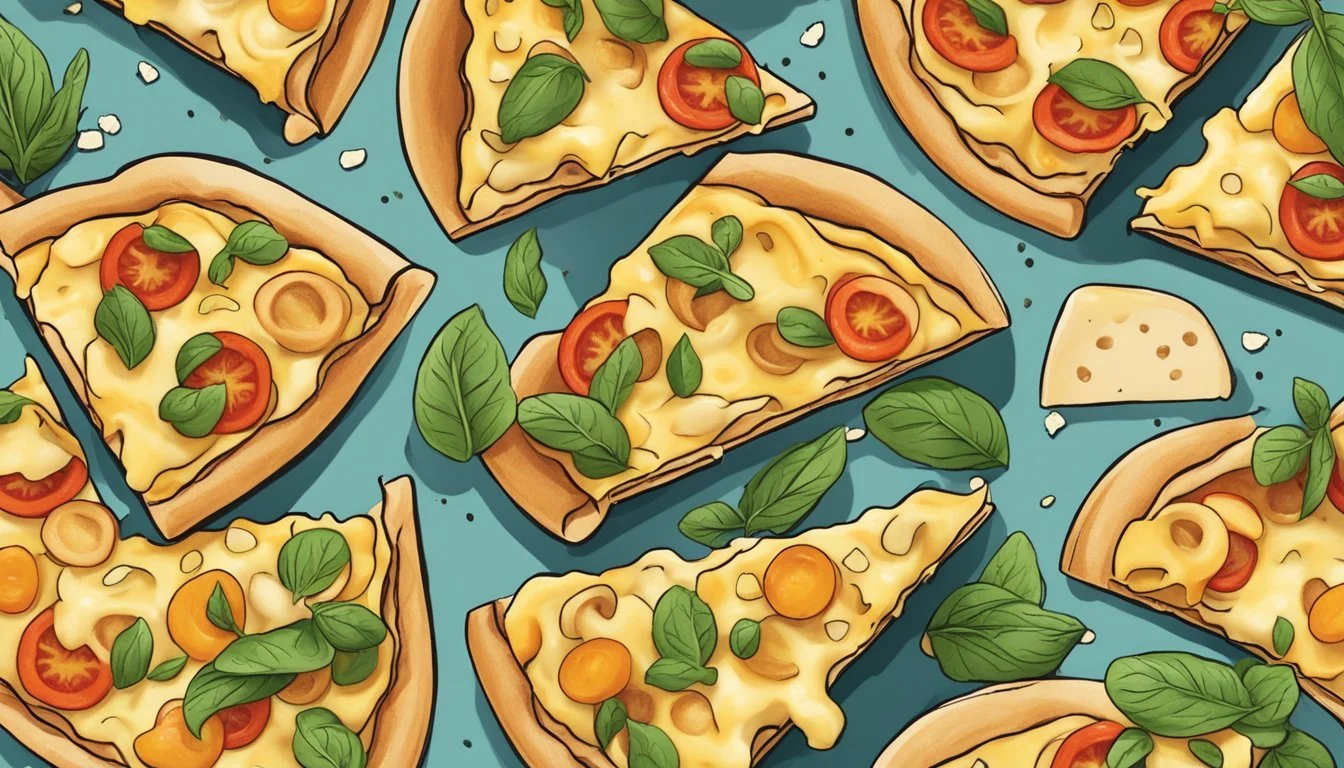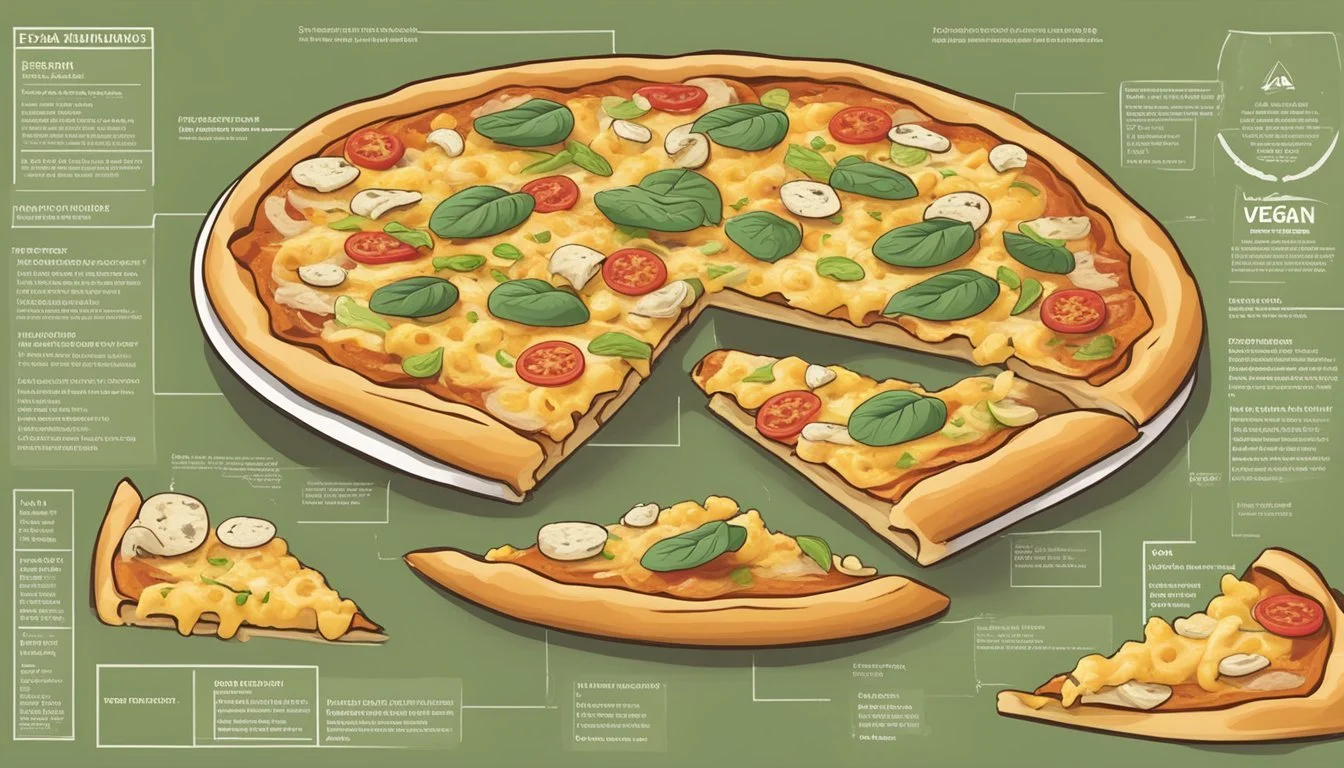Is Mac and Cheese Pizza Vegan?
Unveiling the Truth About This Comfort Food Twist
Mac and cheese (What wine goes well with cheese?) pizza (What wine goes well with pizza?) merges two beloved comfort foods into one dish, offering a unique experience that combines the creamy texture of macaroni and cheese with the crisp crust and convenience of pizza. Traditionally, mac and cheese and pizza both include dairy products, with cheese being a central ingredient in both. Therefore, a classic mac and cheese pizza is not vegan due to the presence of animal-based cheese and other dairy components in the mac and cheese topping as well as the pizza crust and sauce, which may contain dairy or other animal-derived ingredients.
To address the dietary preferences of vegans, culinary creativity has led to the creation of vegan mac and cheese pizza. This version eliminates all animal-derived ingredients and instead focuses on plant-based alternatives to recreate the familiar tastes and textures. The vegan version of mac and cheese pizza employs non-dairy cheese substitutes made from nuts (What wine goes well with nuts?), soy, or other plant sources and a crust that is free of dairy, eggs, or other animal products. Bechamel sauces, cashew creams, and nutritional yeast are often used to replicate the rich and creamy flavors that are characteristic of traditional macaroni and cheese.
Moreover, advancements in vegan food products have also played a significant role in the development of vegan mac and cheese pizzas. With a growing selection of vegan cheeses that melt and stretch similar to their dairy counterparts and a range of plant-based meats for toppings, the modern mac and cheese pizza can be easily adapted to suit a vegan diet without compromising on taste or texture. The result is an indulgent, cruelty-free alternative that aligns with the ethical and health-conscious choices of vegans, offering a gourmet experience that can appeal to both vegans and non-vegans alike.
Understanding Veganism
The move towards veganism requires careful consideration of dietary choices, substitution of non-vegan items, and an understanding of potential health impacts to maintain a balanced diet.
Defining Vegan
A vegan diet excludes all forms of animal products and by-products. This includes meat, dairy, eggs, and honey. Vegans opt for a plant-based diet that focuses on fruits, vegetables, legumes, seeds, and nuts. As such, traditional mac and cheese and pizza—which typically contain dairy cheese and occasionally meat toppings—are not considered vegan.
Health Considerations
Adhering to a vegan diet can contribute to a healthy lifestyle when done correctly. Vegan foods generally contain less saturated fat and emphasize the consumption of nutrients from plant sources. Nutritional essentials such as protein can be found in legumes, tofu, quinoa, and nuts like cashews. In addition, nutritional yeast is a popular ingredient as it provides a cheese-like flavor and is a valuable source of B-vitamins.
Nutrient Sources Examples Protein Legumes, tofu, quinoa, nuts B-vitamins Nutritional yeast, whole grains, nuts Healthy Fats Avocado, nuts, seeds
Vegan Substitutions
To prepare a vegan mac and cheese pizza, traditional ingredients are replaced with their plant-based counterparts. Vegan cheese substitutes, such as those made from almonds or coconut milk, serve as a replacement for dairy cheese. Instead of regular butter, one might use vegan butter in recipes. Some may choose to add vegan pepperoni made from soy or other plant proteins to mimic the flavors of conventional pizza toppings. (What wine goes well with pizza toppings?) Vegan mozzarella can be achieved using cashews and nutritional yeast, lending a creamy texture and savory taste to dishes.
Vegan Mozzarella: Blended cashews, nutritional yeast, water, and seasonings.
Vegan Butter: Oils derived from plants such as olive or sunflower.
Vegan Pepperoni: Crafted from plant-based protein sources like soy.
Mac and Cheese Basics
Mac and cheese is a classic dish traditionally composed of pasta and a creamy cheese sauce. Mastery of mac and cheese begins with understanding pasta choice, creating a velvety cheese sauce, and adapting these elements for vegan alternatives.
Pasta Types and Selection
For mac and cheese, elbow macaroni is the quintessential pasta choice, prized for its ability to hold sauce in its curves. However, shells are another popular option, offering a similar sauce-cradling ability. For those adhering to dietary restrictions, gluten-free pastas made from rice, corn, or quinoa are available.
Preferred pasta types:
Elbow macaroni
Shells
Gluten-free alternatives
Cooking pasta involves boiling it in salted water until al dente, which ensures that it retains a slight bite and doesn't become overly soft during baking if making a baked mac and cheese dish.
Traditional Cheese Sauce
The cheese sauce is the heart of the dish, generally made with cheese, milk, flour, and butter. The traditional method involves creating a roux with flour and melted butter, to which milk is added, forming a thick béchamel sauce. Cheese is then melted into this base to create a rich, creamy sauce.
Key ingredients in traditional cheese sauce:
Cheese (cheddar, Gruyère, or a mix)
Whole milk
Flour
Butter
Vegan Mac and Cheese
Vegan mac and cheese replaces dairy and other animal products with plant-based alternatives to achieve a similar creamy texture and savory taste. Nutritional yeast is a staple for imparting a cheesy flavor without actual cheese. Vegan cheese varieties made from nuts or soy can be used, and thickening agents like cashews or potatoes create the desired consistency.
Common vegan substitutes:
Nutritional yeast for a cheesy flavor
Vegan cheese (nut or soy-based)
Cashews or potatoes for creaminess
By substituting traditional ingredients with these vegan options, it is possible to achieve a mac and cheese that aligns with vegan dietary choices while still satisfying the craving for this comfort food classic.
Pizza Fundamentals
The essence of pizza lies in its crust and the choice of toppings, each contributing unique flavors and textures to create a versatile dish.
Dough and Crust
The foundation of any pizza is the dough, which, after proofing, forms the crust. A basic pizza dough consists of flour, yeast, warm water, and olive oil. They combine to form a pliable dough that is then left to rise, allowing the yeast to ferment and the dough to develop its characteristic flavor and texture. For those following a vegan diet or with gluten sensitivities, vegan pizza crusts and gluten-free options often substitute traditional ingredients with alternatives like gluten-free flours or flaxseed as a binder.
The dough is then shaped and baked in a preheated oven. A properly heated oven is crucial for achieving a crispy outer crust while keeping the inside soft and chewy.
Toppings and Varieties
Toppings are what make pizzas adaptable to a myriad of tastes. The classic layer of tomato sauce is typically garnished with cheese and various proteins or vegetables. In a vegan context, cheese is replaced with plant-based alternatives made from ingredients such as nuts or soy. Vegan pepperoni is a common substitute for the meat version, often made from seasoned plant proteins.
Herbs like oregano and basil contribute aromatic notes, while toppings such as bell peppers add sweetness and crunch to the pizza. The interplay of toppings balances the flavors and complements the crust, creating a harmonious dish that is beloved worldwide.
Creating Vegan Mac and Cheese Pizza
Vegan mac and cheese pizza transforms a classic comfort food into a plant-based favorite, combining the creamy texture of vegan cheese sauce with a crispy crust. Careful selection of base sauces, assembling technique, and baking are crucial for achieving the right balance of flavors and textures.
Alternative Base Sauces
Instead of the traditional tomato paste, a vegan mac and cheese pizza can benefit from a variety of alternative sauces to add depth and complexity. For a tangy twist, one could spread a thin layer of salsa or sun-dried tomato spread on the crust. For those preferring a milder base, a cheesy cashew cream mixed with a pinch of nutritional yeast offers a rich and satisfying foundation.
Assembling the Pizza
To assemble the pizza, one should start with a partially baked pizza crust to ensure a crispy crust upon completion. The vegan mac and cheese, preferably made with a velvety cheese sauce derived from cashews or other plant-based ingredients, is then spread evenly over the crust. Breadcrumbs mixed with melted dairy-free butter can be sprinkled on top to add a crunchy texture. Additional toppings like roasted corn can be added for extra flavor and nutrition.
Baking Techniques
The assembled pizza needs to be baked in a preheated oven at a high temperature to achieve a golden-brown finish and to ensure that the vegan cheese is sufficiently melted. Placing the pizza on the top rack of the oven or using a baking dish that promotes even heat distribution can prevent a soggy bottom and contribute to a perfectly crispy crust. Baking time is typically around 15 minutes, but one should monitor closely as ovens may vary.
Additional Flavor Enhancers
In creating a vegan mac and cheese pizza, one can significantly elevate the dish's flavor profile by incorporating a selection of spices and herbs. These additions not only enhance taste but also contribute unique aromas that can make the pizza more enticing.
Spices and Herbs
Garlic and Onion: A foundational duo in flavor enhancement, garlic and onion deliver a robust aroma and taste. They can be added as fresh, sautéed toppings or as garlic powder and onion powder to infuse the mac and cheese sauce with depth.
Jalapeños: For those who prefer a kick of heat, finely diced jalapeños introduce a spicy complexity. They can be sprinkled atop the pizza before baking for a bold garnish, or mixed into the sauce to distribute the spice evenly.
Sea Salt and Black Pepper: Fundamental seasonings, sea salt and black pepper should be used judiciously to balance and accentuate the natural flavors of the ingredients without overwhelming them.
Paprika Trio: A combination of paprika, smoked paprika, and chili powder offers both color and a spectrum of spicy, smoky notes. These spices work well sprinkled on top or integrated into the 'cheese' sauce.
Red Pepper Flakes: For an extra pop of heat and color, a light scattering of red pepper flakes over the finished pizza adds a visually appealing and spicy touch.
Using these spices and herbs thoughtfully can transform a simple vegan mac and cheese pizza into a gourmet experience.
Serving and Storage
When serving vegan mac and cheese pizza, it is crucial to maintain the dish's flavor and texture. Proper storage ensures the quality remains high for any potential leftovers. Below are specific methods one should use for reheating, freezing, and utilizing leftovers.
Proper Reheating
To reheat the pizza, it is best to preheat the oven to 350°F (175°C). Place the pizza slices on a baking sheet and warm them for about 10-15 minutes or until heated through. For a crispier crust, reheating the pizza in a skillet over medium heat can produce a desirable texture.
How to Freeze and Thaw
Vegan mac and cheese pizza can be frozen for later consumption. To freeze, one should:
Cool the pizza completely at room temperature.
Wrap individual slices or the whole pizza in cling film, followed by a layer of aluminum foil to prevent freezer burn.
Place the wrapped pizza in the freezer, where it can last for up to 2-3 months.
To thaw and reheat, one should:
Transfer the frozen pizza to the fridge and leave it overnight or for a few hours until it is fully thawed.
Once thawed, reheat following the aforementioned oven method to ensure even heating and a revived texture.
Leftover Ideas
Leftover vegan mac and cheese pizza can be incorporated into new meals. They might serve as a side dish, be chopped into bite-sized pieces for a hearty salad topping, or even be added to a soup to create a unique twist. Creatively using leftovers reduces food waste and provides an opportunity to enjoy the dish in various forms.
Dietary Considerations
When considering vegan mac and cheese pizza, diners must contemplate both ingredients and cross-contamination to adhere to dietary restrictions. Below are crucial considerations to ensure that the final product aligns with specific health and dietary needs.
Gluten-Free Options
Individuals adhering to a gluten-free diet should seek out crust alternatives that omit all-purpose flour, a common ingredient that contains gluten. Options for a gluten-free crust typically include:
Pre-made gluten-free pizza bases: Available at most health food stores.
Home-made crusts: Utilize gluten-free all-purpose flour or other substitutes like almond or coconut flour.
It is also essential that any breadcrumbs used for topping should be certified gluten-free to avoid inadvertent gluten exposure.
Soy and Nut Allergies
Vegan cheeses used in mac and cheese pizza often derive from nuts, particularly cashews, or from soy. Those with allergies can consider:
Nut-free cheese alternatives: Made from seeds (such as sunflower or pumpkin) or from oats and potatoes.
Soy-free vegan cheese: Often found in health food stores or can be made at home with a base of carrots and nutritional yeast to provide a cheesy flavor without using soy.
Cross-contamination is a concern in both gluten and allergen-free cooking, so it's imperative that the preparation area is free from the specific allergens and that all utensils and cookware are thoroughly cleaned beforehand.
Nutritional Information
When considering the nutritional profile of vegan mac and cheese pizza, it's important to understand the components that make up the dish. This pizza typically contains a crust, vegan cheese, and pasta. These elements contribute to the overall caloric content and macronutrients such as protein and fats.
The calories in a slice of vegan mac and cheese pizza can vary depending on the ingredients used. However, a rough estimate would indicate that a standard slice contains between 200 to 300 calories.
Regarding macronutrients, the protein content in vegan mac and cheese pizza primarily comes from the pasta and vegan cheese. Vegan cheeses are often made from nuts which provide a moderate amount of protein. Whole-wheat pasta or pasta made from legumes can further increase the protein content. A slice could offer between 5 to 10 grams of protein, depending on the specific ingredients used.
The fat content, especially saturated fat, can be lower in vegan mac and cheese pizzas compared to their non-vegan counterparts due to the absence of dairy cheese. However, the use of certain vegan cheeses and butters, which may contain coconut oil, a source of saturated fat, should be considered.
Lastly, some ingredients in vegan mac and cheese pizza are nutritious, offering dietary fiber, vitamins, and minerals. For example, whole-grain crust and pasta contribute to the fiber content, while nutritional yeast used in vegan cheese provides B-vitamins.
Nutrient Estimated Amount per slice Calories 200 - 300 kcal Protein 5 - 10 g Saturated Fat Varies Dietary Fiber Varies
Nutritional values are approximate and can vary based on recipe ingredients and serving sizes.







